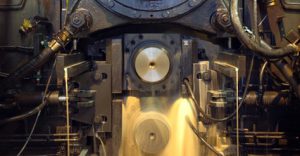-
Cold rolling mill
In our cold rolling mills (Ghent & Liège) we convert steel strips into a finished product with a thickness of no less than 0.15mm and no more than 3mm.
How does this work?

First we need to remove the scale layer which was formed during hot rolling. This is done by sending the coil through a heated acid solution, a process referred to as “pickling”.
In the tandem mill groups, the strips are rolled out until they reach the required thickness. The tandem mills consists out of a series of rolling stands that thin the steel strips. One of our tandem mills works exclusively for the automotive industry, the other produces products for the remaining branches.
After having passed through the cold rolling mill, the steel strip is hardened. This entails that it is no longer able to be processed further. This is why, in order to make the steel cold deformable, it needs to undergo a heat treatment. This can be done in the batch annealing section or in the continuous annealing and processing line.
The continuous annealing and processing line is equipped with a skin-pass machine, which gives the strip of steel its needed elongation, roughness and flatness. Steel strips that were heated in the batch annealing section, receive additional treatment in the skin-pass.
The cold rolling mills are also equipped with shearing lines, that cut the coils on length and width.
In our inspection lines, we are able to additionally check the sheet’s surface. If needed, we can bring the coil to a certain weight by welding or cutting it.
The cold rolled coil can now be finished further at our company or, if required, we can package it and send it to our customers.
-
Production process
Before
Afterwards


